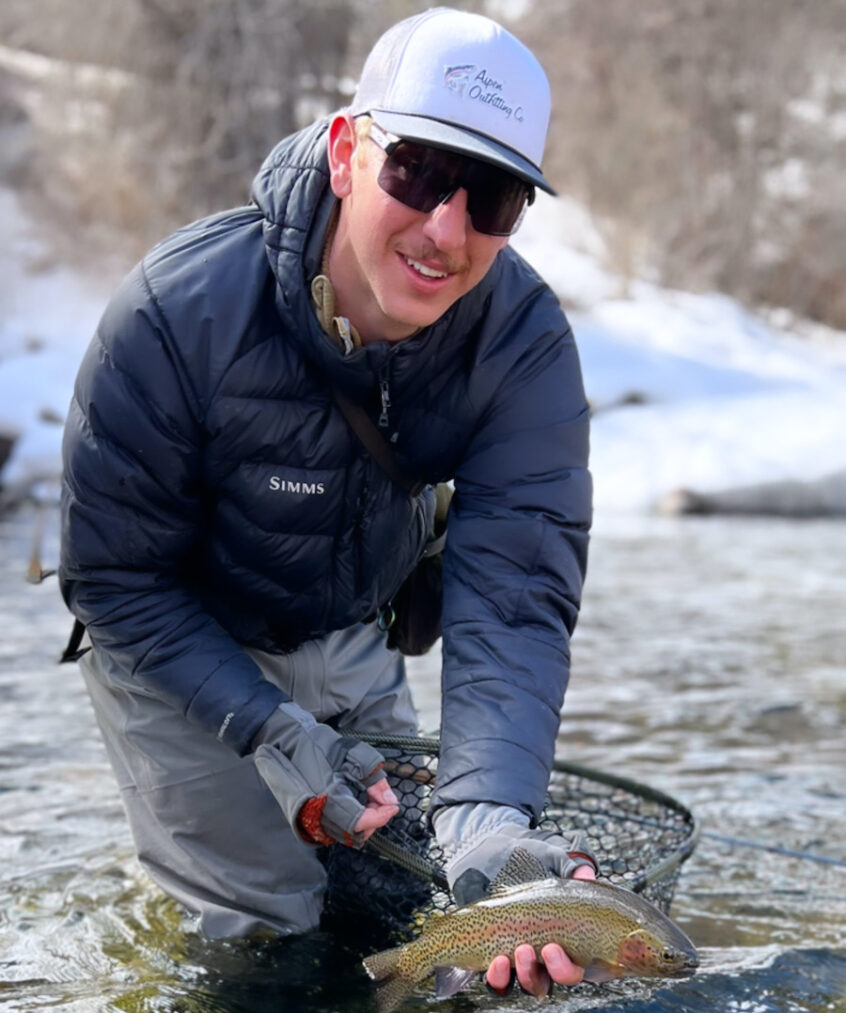Flows and Water Clarity
The Roaring Fork is running low and clear. Flows are approximately 40 cfs below Maroon Creek and 187 cfs at Emma. Water temperature remains in the mid to low thirties.
Overview
Conditions have remained consistent this past week, and so has the fishing! Leading with perdigons, two bit hookers and Pat’s Runt Stones (size 14-16) and trailing small midge and baeits imitations has been the ticket. Fly selection is important, but we’re finding that fish are eating pretty readily as long as you get a good, drag free drift!
As always, safety is the number one priority on the river. Ice has been building up in parts of the upper fork. Ice shelves are prone to breaking, and ice dams can be a concern. Fish with a friend, keep an eye up-river for ice flows and if you see the water levels starting to rise, move away from the water.
We’re finding the most success by fishing midday and well into the afternoon, even on snowy days. When water temperatures are low, make sure that you find slower, deeper water– particularly before 11 and after 3. On sunny days, we’re finding some fish in shallower water and even seeing pods of rising fish!
Click Here to watch Jarrod and Tom (@livinfly) get into some winter Dry Fly Action!
Having the right gear can mean the difference between having a good day and a great day. Warm hands are key for maintaining dexterity, although some of our guides maintain that they can fish barehanded if they dress warmly enough, we recommend fingerless gloves and foldback mittens on colder days. When it’s really cold, throwing a hand warmer in your gloves or wader pocket is a great move.
Common Hatches and Food Sources
Midges, Baetis, and Stoneflies.
Midge Larvae and Baetis nymphs are the standard sources of food present in the upper fork during the winter. But, we must say that small stonefly patterns have also been crushing it! Try the Element Flies Pat’s Stone Runt (size 16, black) or a Two Bit Hooker (size 16, black).
On warmer days, we’re still seeing some fish rise intermittently to eat hatching midges, so make sure you have some size 18-22 midge imitations in your box!
We haven’t been seeing them yet, but the caddis should start moving around soon. Keep an eye out for caddis as we move later into march.
Hot flies & Techniques
Nymphs
Midges and Baetis
Hot Flies: Foamback RS2 (gray, size 20), Rainbow Warrior (pearl, purple, size 20)
Zebra Midge (black, gray, size 18-22), WD40 (black, gray, size 18-22), Miracle Midge (gray, brown, size 18-22) RS2’s (cdc, crystal wing, black, gray, size 18-22), crystal midge (gray, olive, size 20-22), Juju Baetis (red, olive, black size 18-22), Pheasant Tail (natural 18-20).
Point Flies
Hot Flies: Pat’s Stone Runt (black, size 16), Two bit Hooker (black, size 14-16), Perdigon (pearl, size 16).
Tungsten jigs with hot collars (yellow, brown, pink, size 14-18), Bead Head Rainbow Warrior (classic, purple, red, size 16-20), Eggs (chartreuse, peach, white). Perdigons (olive, black, 16-18).
Dries:
Hot Flies: Griffith’s gnat (classic or hi-vis, 18-22)
Element Hi-Vis Midge (black, size 20) Parachute Adams (18-20), BWO Hackle Stacker (18-20)
Streamers:
Motor Oil (black, size 6), Slumpbuster (natural, size 8-12), Thin Mint (size 6-10).
Techniques
Nymphing is the most productive technique during this time of year. Finding deep holding water and using weight to get your flies down will be crucial to success. Longer leaders and heavy split shot will help you get your flies in front of more fish. Leading with larger jig style or tungsten patterns has been a very productive technique for helping smaller flies get down deeper.
With the cold temperatures, your floating line and line guides are at risk of freezing over so treating your guides and line with ice off paste can help extend your time on the water. With low water temps there are less insects hatching, so the fish are hungry. Small midges and baetis are the staples when fishing this time of year, but don’t be afraid to try something out of the ordinary. Small stoneflies are working surprisingly well right now! If you’re not finding success, get creative with your point flies– larger bugs have been producing occasionally too!
With warmer days forecasted ahead, keep an eye out for pods of rising fish. Winter dry fly hatches can be few and far between, but are incredibly fun and rewarding to fish. Midges are the predominant hatch right now, so switching to small dry flies and fine tippet is your best chance at fooling fish. Small streamers are also an option this time of year, but be sure to focus your efforts on deep pools and structure.
Wintertime Fish Feeding Habits
As we mentioned last week, trout metabolism is a factor for winter anglers. Trout are cold blooded, so their metabolism is regulated in large part by water temperature. Pay close attention during the warmest part of the day this weekend, as the water temperature is likely to increase after the recent cold snap. A change of even a couple of degrees can have big consequences! Look for fish becoming more adventurous/opportunistic with their menu choices, and feeding more aggressively overall.
Information About The Roaring Fork
The Roaring Fork River is a freestone river that runs 70 miles from Independence Pass through Aspen, Basalt, and Carbondale until it reaches its confluence with the Colorado River in Glenwood Springs. The cold, clean waters of this famous river support an incredible array of aquatic life including brown, rainbow and cutthroat trout. The Roaring Fork is designated as a “Gold Medal” fishery, meaning it offers some of the best trout fishing in the nation to beginners and seasoned anglers alike.
Written by AOC Shop Staff, Photo by Jarrod Hollinger

